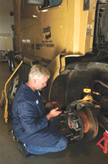While braking system suppliers to the trucking industry continue to bring new technologies and specification choices to fleets, the desire to improve safety and stopping performance is hardly new. For example, one only needs to look back to March 2001 and read the Future Truck Program Position Paper on Future Braking System Equipment User Expectations by the Technology & Maintenance Council’s (TMC) Future Chassis (Brakes) Task Force.

“Today’s conventional braking system is a cost-effective solution,” the paper said. “However, the trucking industry has expressed the need for further enhancements resulting in improved product performance, maintenance and safety, while meeting requirements for increased Gross Vehicle Weight (GVW) and anticipated changes in vehicle deigns and future improvements.”
As if they had a crystal ball, the fleet mangers who authored the TMC document foresaw a National Highway Traffic Safety Administration (NHTSA) December 2005 Notice of Proposed Rulemaking (NPRM) calling for a 20 to 30 percent reduction in the required stopping distance for large trucks. In fact, one of the future brake system requirements outlined in the paper was for Stopping Distance and Stability. “Future braking systems,” the authors wrote, “should significantly reduce stopping distance and result in a safer vehicle under all driving conditions.”
NHTSA is currently reviewing industry comments about its proposal and a final rule is expected. By most accounts, implementation of a new requirement for shorter stopping distance could take effect by 2009 for typical highway tractors and by 2011 for special configurations. If new stopping distance requirements are mandated, the rule will only affect tractors initially, although ongoing research by NHTSA may impact future stopping distance requirements for all air braked vehicles, including trailers and trucks.
Optimizing systems
A good indication of the technologies manufacturers will deploy to meet the proposed stopping distance regulations were presented in a recent Web-based seminar hosted by ArvinMeritor (www.meritorhvs.com) and MeritorWABCO (www.meritorwabco.com). Anticipating a 30 percent reduction in the final rule, the companies said they have current technologies in place to meet proposed requirements and are working with truck OEMs – who ultimately will be responsible for certifying stopping distance requirements are met – to optimize braking systems.

Multiple product options are available from ArvinMeritor and Meritor WABCO to meet proposed stopping distance regulations, according to the companies. The options will maximize benefits and minimize impact for fleets. These include newly redesigned high performance cam brakes as well as a full line of air disc brakes for heavy-duty commercial vehicle applications.
Bendix Spicer Foundation Brake (www.bendix.com) also is prepared for the onset of new stopping distance regulations with both drum and disc brake solutions. “Depending on the application, there are a number of drum brake, disc brake and disc-drum brake compatible combinations that will provide safety, performance and overall value to meet the proposed stopping distance reduction,” said Jim Clark, director, foundation drum brakes. “Fleet managers will weigh a variety of factors – up-front cost, maintenance intervals, replacement parts, driver retention, vehicle applications, etc. – and will have different philosophies as to how they’re going to spec new rigs after the final regulations take effect.”
Haldex Commercial Vehicle Systems (www.hbsna.com) also is prepared to help fleets meet new stopping distance standards with a range of products for installation on new vehicles. The manufacturer’s offerings include air disc brakes for heavy-duty applications. Air disc brakes are especially responsive and less sensitive to speed and temperature variations, Haldex said. Those attributes lead to better stability and significantly shorter stopping distances on heavy-duty vehicles.
Highly feasible
NHTSA said it believes that braking system technology has advanced to the point that shorter stopping distances for tractors are feasible.
“We believe that due to recent technological advances in heavy-duty vehicle brakes, required stopping distances for these vehicles can be made substantially shorter, ” an agency research report said.
That’s a conclusion that also was reached by TMC more than five years ago. Included in its future truck brake systems paper, after all, was the very forward-looking statement about the ability of future braking systems to significantly reduce stopping distances.
The TMC position paper, which described in detail the performance, maintenance and operational requirements fleet managers desired for future braking systems during the next five to 10 years, did not recommend specific solutions. Instead, the paper said, “it provides manufacturers an opportunity to develop and manufacture products for the North American trucking industry that meet certain fleet-driven expectations.”
Today, heavy-duty commercial vehicle braking systems are called on to respond effectively and bring vehicles to a safe controlled stop in as short a distance as possible. Recognized by NHTSA in its proposed stopping distance regulation reductions is a growing need to enhance braking performance even further. What’s equally clear is that manufacturers have risen to the challenge, and have developed a variety of solutions that can meet even the strictest new stopping distance requirements that might be imposed. When spec’ing brake systems in the future, fleet managers will find that they not only have a range of viable choices to meet their needs, but a cost effective way to do so as well.




